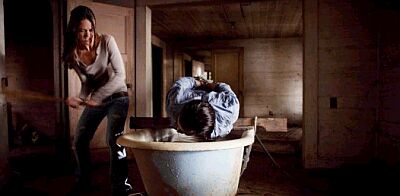Originally posted on 4/22/2020
Filmmaker Al Adamson made a lasting name for himself by creating lurid low-budget exploitation movies with that indefinable "so bad it's good" greatness that many strive for but few achieve. A well-made documentary about his lively career would be interesting enough, but even more so if his personal life ended on a note that was way more fascinating, mystifying, and downright creepy than any of his actual films ever came close to being.
BLOOD & FLESH: THE REEL LIFE & GHASTLY DEATH OF AL ADAMSON (Severin Films) is that documentary, and it's well-made indeed. It's tricky to construct a documentary with just the right balance of talking heads and informative narration, along with movie clips and other audio-visual elements, while maintaing our interest to the same degree as a fictional narrative, and this one does so in a way that's utterly involving.
Any collection of clips from Adamson's films would be fun to watch, and here we get plenty of footage from such trash classics as "Satan's Sadists", "Horror of the Blood Monsters", "Brain of Blood", "The Female Bunch", "Blazing Stewardesses", and of course what some might consider his magnum opus, the immortal "Dracula vs. Frankenstein."
These are augmented by interview clips with the most important players in the Al Adamson saga, including (besides Al himself) such familiar names as Vilmos Zsigmond, Russ Tamblyn, Fred Olen Ray, Gary Graver, and many others who offer a wealth of personal stories about working with a man whom most remember very fondly, some with gratitude for helping them begin successful careers in the film business. (Celebrated cinematographer Laszlo Kovacs also started out with Adamson.)
Best are the stories of Adamson's endearing eccentricities and his devotion to making films not to win awards but simply to entertain the masses, using his imagination and ingenuity to overcome meager budgets and resources that would severely daunt other struggling filmmakers.
His exploits in the field serve as a primer for others wishing to follow in his footsteps and are scintillating stuff for those of us who simply love hearing about such adventures.
Adamson's efforts to knock together these films, usually offering his cast and crew valuable experience rather than money, also include the fascinating field of promotion and distribution in which such commodities were sold to the public in whatever form and by whatever means would be most exploitable.
Thus, a film about outlaw bikers might, if trends suddenly changed, be transformed through editing, reshoots, and a new title into a horror or crime thriller.
Conversations with Oscar-winner Russ Tamblyn are fun since he takes an amusedly lighthearted view of his association with the B-movie maven. Like many stars persuaded to participate in these films, Tamblyn was a big name on his way down who was happy for the work since Hollywood was no longer calling. Others included the likes of John Carradine, Kent Taylor, Broderick Crawford, Yvonne DeCarlo, J. Carroll Naish, and Lon Chaney, Jr.
The latter two joined Tamblyn for what may be Adamson's most celebrated classic, "Dracula vs. Frankenstein", which underwent drastic thematic changes during its creation (the original script didn't even include the title monsters).
Dealing with an alcoholic Chaney and a wheelchair-bound Naish, with his noisy dentures and inability to remember his lines, are just two of the interesting elements of this film's production.I had the pleasure of seeing it on a double bill with "Horror of the Blood Monsters" back in the 70s, a movie-going experience that I still treasure.
Long-time producer and partner Sam Sherwood adds invaluable personal knowledge of everything including Adamson's devotion to his wife Regina Carrol, a blonde bombshell who starred in many of his later films until her untimely death from cancer, and a strange project he undertook concerning UFOs and aliens which Sherwood believes was discontinued under shady circumstances involving the government.
But most mysterious of all are the circumstances surrounding Adamson's death, the details of which are fully explored in the film's final third and have all the morbid fascination of an Ann Rule true-crime book.
Even the director's previous association with Charles Manson and his flaky followers at Spahn Movie Ranch pales in comparison to the story of his disappearance from his desert home and the following investigation which uncovered a grisly fate that's right out of a horror movie.
The Blu-ray from Severin Films consists of not only this film but a bonus feature, Adamson's 1971 sleazefest "The Female Bunch" which co-stars a hard-drinking Lon Chaney, Jr. as well as Russ Tamblyn and Regina Carrol. Pieced together from the best available elements, the print has a delightful grindhouse feel.
The disc also offers some irresistible--one might even say essential--outtakes from the documentary including an in-depth look at Adamson's western movie star father Denver Dixon, Russ Tamblyn's mysterious melted TV, some more creepy stuff about Charles Manson, and a promo reel for that eerie, unfinished project about aliens and UFOs.
Regardless of the man's gruesome demise, however, what lingers most for me after watching BLOOD & FLESH: THE REEL LIFE & GHASTLY DEATH OF AL ADAMSON is his joyous devotion to making exploitation movies and, we discover, his delight that after many years they were still being enjoyed and even revered by fans old and new. That many of his most fervent fans include the very people who knew him best is a testament that this documentary so richly conveys.
Buy it from Severin Films
Special Features:
Outtakes – The Cowboy Life Of Denver Dixon, Russ Tamblyn’s Melted TV, Manson & Screaming Angels, and The Prophetic Screenplay Makes Gary Kent Testify
Beyond This Earth Promo Reel
Trailer
BONUS FILM: The Female Bunch
The Bunch Speaks Out
THE FEMALE BUNCH Trailers
WATCH THE TRAILER:







































